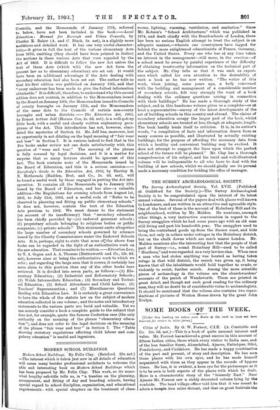MODERN SCHOOL BUILDINGS.
Modern School Buildings. • By Felix Clay. (Botsford. .25s. net.) —The interest which is taken just now in all details of education will cause many besides professional architects to welcome the able and interesting book on Modern School Buildings which has been prepared by Mr. Felix Clay. This work, as its some- what lengthy sub-title tells us, is "a treatise on the planning, arrangement, and fitting of day and boardink schools, having special regard to school discipline, organisation, and educational requirements : with special chapters on the treatment of class-
rooms, lighting, warming, ventilation, and sanitation." Sinoe Mr. Robson's " School Architecture," which was published in 1874, and dealt chiefly with the Board-schools of London, there has been no serious English attempt to treat the subject in an adequate manner,—wherein our countrymen have lagged far behind the more enlightened educationists of France, Germany, and the United States. Every one who has at any time taken an interest in the management—still more, in the erection—of a school must be aware by painful experience of the difficulty of obtaining trustworthy information on the technical part of the subject. Mr. Clay tells us that it was such an experi- ence which called his own attention to the desirability of such a book as he has now written. "The writer of this work, when joining, some years ago, a body concerned with the building and management of a considerable number of secondary schools, felt very strongly the want of a book dealing with the ordinary questions arising in connection with their buildings." He has made a thorough study of the subject, and in this handsome volume gives us a complete—or at least a representative—survey of the latest developments of the art of building schools in this country and abroad. The claims of secondary education occupy the larger part of the book, whilst elementary schools are treated at less, though at adequate, length. The book hardly lends itself to criticism. It is, in its author's words, "a compilation of facts and information drawn from as many sources as possible, and illustrated by actually existing buildings, for the purpose of affording the necessary data from which a healthy and convenient building may be evolved. It does not attempt to suggest the lines upon which the perfect school of the future will be planned." Mr. Clay has a thorough comprehension of his subject, and his lucid and well-illustrated volume will be indispensable to all who have to deal with the building of new schools, whilst we should gladly see its perusal made a necessary condition for holding the office of manager.










































 Previous page
Previous page